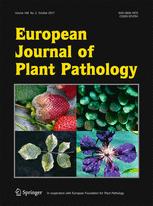Ver ítem
- xmlui.general.dspace_homeCentros e Institutos de InvestigaciónCIAP. Centro de Investigaciones AgropecuariasInstituto de Patología VegetalArtículos científicosxmlui.ArtifactBrowser.ItemViewer.trail
- Inicio
- Centros e Institutos de Investigación
- CIAP. Centro de Investigaciones Agropecuarias
- Instituto de Patología Vegetal
- Artículos científicos
- Ver ítem
Occurrence and characterization of a severe isolate of Watermelon mosaic virus from Argentina
Resumen
More than 50 viruses have been reported in cucurbit crops worldwide. In Argentina, cucurbit viruses have been associated with important yield losses. The most prevalent and widespread potyvirus is Watermelon mosaic virus (WMV). WMV was detected in Argentina in all cucurbit species with high incidence. In this study, a WMV isolate (WMV 1 SDE FF) was obtained from a naturally infected squash associated with a severe outbreak on melon and squash crops in an
[ver mas...]
More than 50 viruses have been reported in cucurbit crops worldwide. In Argentina, cucurbit viruses have been associated with important yield losses. The most prevalent and widespread potyvirus is Watermelon mosaic virus (WMV). WMV was detected in Argentina in all cucurbit species with high incidence. In this study, a WMV isolate (WMV 1 SDE FF) was obtained from a naturally infected squash associated with a severe outbreak on melon and squash crops in an important cucurbit growing area in Santiago del Estero province (Argentina), during a survey conducted in November 2012. The fully sequenced WMV 1 SDE FF genome consists of 10,027 nucleotides and shares 96 % nt identity and 98 % aa identity with the French isolates JF273464.1|C07–014 and EU660581.1|FMF00-LL1 of the WMV molecular group 3. Using the recombination detection program RDP4, two statistically significant recombination events were identified: event 1, an 830-nt long recombinant fragment in the putative P1 coding region, and event 2, a 4071-nt recombinant fragment detected across the HC Pro, P3 and CI coding regions. The putative parental sequences detected for event 1 were the EU660586.1| FBR04–37 (major parent) and JF273468.1|C07–284 (minor parent), both from France. Putative parental sequences for event 2 were JX079685.1| WMV-ShanXi (major parent) and HQ384216.1|Dendrobium (minor parent), from China and USA, respectively. To our knowledge, this is the first complete genome of an Argentine WMV isolate. Our results provide evidence that WMV 1 SDE FF is the causal agent of the strong outbreak reported in melon and squash fields in recent years.
[Cerrar]

Fuente
European Journal of Plant Pathology 146 (1) : 213–218 (September 2016)
Fecha
2016
ISSN
0929-1873 (Print)
1573-8469 (Online)
1573-8469 (Online)
Formato
pdf
Tipo de documento
article
Palabras Claves
Derechos de acceso
Abierto
 Excepto donde se diga explicitamente, este item se publica bajo la siguiente descripción: Creative Commons Attribution-NonCommercial-ShareAlike 2.5 Unported (CC BY-NC-SA 2.5)
Excepto donde se diga explicitamente, este item se publica bajo la siguiente descripción: Creative Commons Attribution-NonCommercial-ShareAlike 2.5 Unported (CC BY-NC-SA 2.5)


